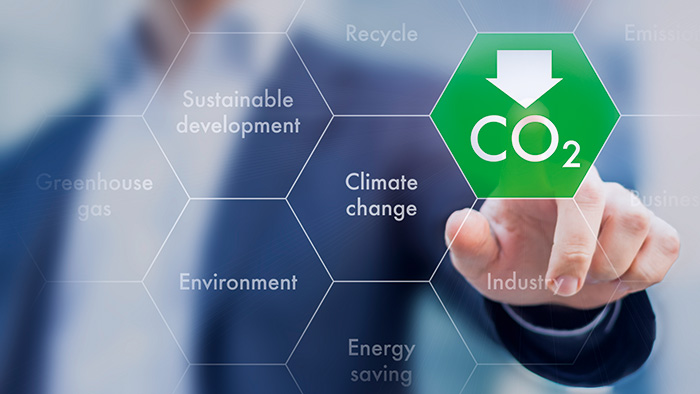Carbon Capture, Utilization, and Storage (CCUS): Key Bottlenecks and Opportunities

Much of the anthropogenic carbon dioxide (CO2) released into the atmosphere comes from the combustion of fossil-derived fuels (coal, petroleum, methane, and other gases) as well as biomass and bio-derived liquid fuels for energy generation. These fuels' hydrocarbons are burned to provide energy for transportation, as well as to provide electricity and heat for homes, workplaces, and industry. CO2 levels have grown dramatically as global energy demands have expanded, from pre-industrial levels of 280 ppm a century ago to over 400 ppm since 2013. Another important factor for large-scale deployment is increasing public acceptance of CCUS as a realistic and effective mitigating technique.
The CCUS Is Gaining New Momentum As A Result Of Its Net Zero Targets
With plans for more than 100 additional facilities planned in 2021, CCUS is gaining tremendous momentum thanks to strengthened climate goals and new investment incentives. CCUS technology will be critical in achieving net zero targets, being one of the few options for reducing heavy industry emissions and removing carbon from the environment. Although recent progress is encouraging, the current project pipeline will fall well short of the 1.7 billion tonnes of CO2 capture capacity required by 2030 in the Net Zero by 2050 scenario.
What Is Ccus Technology, And How Does It Work?
Carbon Capture, Usage, and Storage (CCUS) is a technology that can capture and use significant concentrations of CO2 released by industrial processes. As a result, it plays a critical role in decarbonization and solving the global climate change crisis. Along with strategies to encourage CCUS, Japan is actively researching and marketing Direct Air Capture technology, which can recover CO2 directly from the atmosphere beyond pollutants generated by industrial activity, through its "MOONSHOT programme. More information about this amazing programme may be found here.
CCUS's Industrial Applications
Large volumes of CO2 are released during the fire of limestone and clay, which divides the minerals into CO2 and calcium oxide, in the cement and concrete industries (CAO). To solve this issue, research initiatives are underway around the world to test novel technologies for recovering and recycling CO2 produced during this process, as well as developing new concrete formulations that actively take CO2 from the atmosphere and trap it inside the concrete when it hardens.
Bio-jet fuel must be promoted urgently in the fuel and basic chemicals industries to help the aviation industry minimize its carbon footprint. New technology that makes synthetic gas from multiple carbon sources, such as recovered CO2, is one possible option. This synthetic gas, when integrated with biochemical reactions and biotechnology based on catalytic reactions and microorganisms, can now be utilized to manufacture hydrocarbon fuels and basic chemicals, helping to decarbonize these industries. Although the opportunity for absolute CO2 emissions reductions in the fine chemicals industry is minimal compared to other industrial sectors due to low production volumes, it does offer chances to make a significant environmental effect. A substantial quantity of research is being conducted around the world on technologies that can convert CO2 and biomass into oxygenated molecules like high-functional polymers.
Cost-cutting opportunities for CCUS
Despite the fact that absorption-based carbon-capture technology has been around for over 40 years32, there are still significant cost-cutting options in that and other approaches. As more CCUS facilities open, there will be plenty of opportunities to learn by doing, as well as for CCUS prices to fall over time as different systems try out new innovations and uncover incremental cost-cutting enhancements or other modifications. In order to arrive at the stated long-term trajectories of CCUS costs and deployment, both learning by doing and technological breakthroughs are commonly considered.
Many other CCUS technologies are currently in the early phases of development and have the potential to lower prices much more. Next-generation solvents for absorption-based capture, as well as more efficient membranes and adsorption systems and innovative carbon capture technologies like calcium-looping technology, could require less energy.
CCUS's Continuing Challenges and Opportunities
Increases in the value of the 45Q tax credit, as proposed in the Build Back Better Act, might go a long way toward motivating CCUS adoption in the United States, as CCUS prices remain the principal barrier to deployment. According to published CCUS cost estimates, the Act's additional $35 per tonne of CO2 sequestered and $25 per tonne of CO2 utilized should make CCUS cost competitive for many plant configurations. CCUS in natural-gas-fired power plants and hydrogen production facilities, however, is unlikely to become economically viable at this incentive level, and many CCUS configurations with cement and steel facilities are also unlikely to become economically viable without larger incentives or technological breakthroughs.
Predicting technological advancement is always a risky proposition. A suitably high carbon price, for example, would create a substantial incentive for technological innovation in CCUS across all industries, as well as incentivizing the implementation of existing choices on a national basis. If the definition of clean power just includes renewable technologies and nuclear power, policies that reward clean power generation may disfavor CCUS, but if the controlling criterion is total emissions, they may give additional incentives for CCUS.
The transportation infrastructure required for either usage or sequestration is another barrier to widespread adoption of CCUS. Construction of a new CO2 pipeline network of roughly 110,000 km may be required to sustain CCUS across the country while keeping costs low.
Major Developments In The Industry
- Baker Hughes, a US-based business that specializes in carbon capture and storage, purchased Compact Carbon Capture (3C) for an unknown sum in November 2020. Baker Hughes' strategic commitment to leading the energy transition by offering decarbonization solutions for carbon-intensive industries like oil and gas, as well as broader industrial activities, is strengthened by this acquisition. Compact Carbon Capture (3C) is a technological business established in Norway that specializes in developing carbon capture technologies.
- Furthermore, due to the economic downturn, demand for CCS has decreased as demand for oil and gas has decreased, resulting in a decrease in the usage of collected carbon dioxide for increased oil recovery (EOR). Due to diminishing demand, Petra Nova, a huge CCS project in Texas that provided carbon dioxide for EOR, was shut down in 2020. The short-term forecast for CCS M&A is certainly impacted by the drop in demand.
- OGCI Climate Investments and Starwood Energy announced in 2020 that they would partner to create a significant carbon capture project at a gas-fired power plant. The project is expected to capture around 90% of the carbon dioxide emissions from the plant using commercially available technology, which would then be used in EOR or sequestered in an existing oil field. Construction is planned to begin in 2021, and the project will be eligible for 45Q tax credits, according to reports.
Conclusion
CCUS will play a vital role as a level of skill to reduce numerous risks, notably for the energy - intensive industrial sectors, due to technology, market, and legislative variables that may affect the pace of the energy transition. CCUS offers a critical alternative and a prevention way of measuring that governments and corporations can continue pursuing through rising investments in order to combat such detrimental results scenarios where either the implementation of renewable energy investments falls short of contemplated plans or emission reduction metrics underdeliver. Governments and regulators can help the industry move forward on the learning curve by establishing incentives that enable quicker deployment of CCUS.











